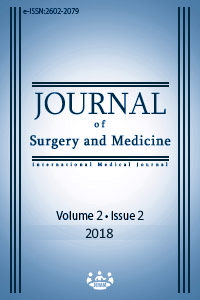The effect of insulin resistance on House-Brackmann grade of facial paralysis in patients with Bell’s palsy
Keywords:
Insulin resistance, House-Brackmann, Facial paralysisAbstract
Aim: Bell's palsy is the most common cause of facial nerve lesion and is frequently observed in diabetic patients and the duration of healing is delayed in diabetic patients. To investigate the effect of insulin resistance on the facial paralysis as graded by the House-Brackmann classification in patients with Bell’s palsy and to determine the importance of insulin resistance assessed primarily prior to treatment planning .
Methods: Patients admitting to our emergency department and outpatient neurology clinic with suspected facial paralysis who were not administered steroid therapy within the first 24 hours were studied. Demographic data were collected for patients with Bell’s palsy from different age groups with a normal body mass index (BMI) and no chronic endocrine disease. The House-Brackmann (HB) grading scale was used to assess the clinical severity of the facial paralysis. In addition to routine laboratory tests, fasting insulin level was obtained to estimate HOMA-IR (Homeostatic model assessment for insulin resistance) for all patients.
Results: Of 19 patients enrolled, 10 were female (52.6%). Patients had a mean age of 33 years, mean glucose value of 106 mg/dL, mean insulin value of 15.9 µU/mL and mean HOMA-IR value of 4.1. A moderate positive correlation and a statistically significant association were found between mean glucose values and HOMA-IR values (r=0.548; P=0.015) Age and glucose values were not statistically significantly associated with insulin and HOMA-IR values (p=0.858 and p=0.015, respectively).
Conclusion: Higher blood glucose and average insulin levels were found in patients with facial nerve paralysis in comparison to general population. Most of the patients were IR-positive. Therefore, assessment of insulin resistance would be beneficial for both treatment planning and taking proactive measures against future development of diabetes in all patients presenting with Bell’s palsy.
Downloads
References
McCaul JA, Cascarini L, Godden D, Coombes D, Brennan PA, Kerawala CJ. Evidence based management of Bell’s palsy. Br J Oral Maxillofac Surg. 2014;52:387–91.
Mooney T. Diagnosis and management of patientswith Bell’s palsy. Nurs Stand. 2013;28:44–9.
Monini S, Lazzarino AI, Iacolucci C, Buffoni A, Barbara M. Epidemiology of Bell’s palsy in an Italian health district: incidence and casecontrol study. Acta Otorhinolaryngol Ital. 2010;30:198.
Movahedian B, Ghafoornia M, Saadatnia M,Falahzadeh A, Fateh A. Epidemiology of Bell’s palsy in Isfahan, Iran. Neurosciences (Riyadh). 2009;14:186–7.
Savadi-Oskouei D, Abedi A, Rostami K. Environmental factors in incidence of bell’s palsy in ardabil. Res J Biol Sci. 2004;3:18–23.
Narcı H, Horasanlı B, Ugur M. Seasonal effects on Bell’s palsy: four-year study and review of the literature. Iran Red Crescent Med.J. 2012;14:505–6.
Zohrevandi B, Monsef Kasmaee V, Asadi P, Tajik H. Report of 121 cases of Bell’s palsy referred to the emergency department. Emerg (Tehran). 2014;2:66–70.
Flier JS. Lilly Lecture: syndromes of insulin resistance. From patient to gene and back again. Diabetes. 1992;41:1207-19.
Hollenbeck C, Reaven GM. Variations in insulin stimulated glucose uptake in healthy individuals with normal glucose tolerance. J Clin Endocrinol Metab. 1987;64:1169-73.
House JW, Brackmann DE. Facial nerve grading system. Otolaryngol Head Neck Surg. 1985 Apr;93(2):146-7.
Matthews DR, Hosker JP, Rudenski AS, Naylor BA, Treacher DF, Turner RC. Homeostasis model assessment: insulin resistance and beta-cell function from fasting plasma glucose and insulin concentrations in man. Diabetologia. 1985 Jul;28(7):412-9.
.Wallace TM, Matthews DR. The assessment of insulin resistance in man. Diabet Med. 2002;19:527–34.
Bonora E, Kiechl S, Willeit J, Oberhollenzer F, Egger G, Meigs JB, et al. Population-based incidence rates and risk factors for type 2 diabetes in white individuals: the Bruneck study. Diabetes. 2004;53:1782–9.
Gungor N, Hannon T, Libman I, Bacha F, Arslanian S. Type 2 diabetes mellitus in youth: the complete picture to date. Pediatr Clin North Am. 2005;52:1579–609.
Kurtoglu S, Hatipoglu N, Mazicioglu M, Kendirici M, Keskin M, KondolotM. Insulin resistance in obese children and adolescents:HOMA-IR cut-off levels in the prepubertal and pubertal periods. J Clin Res Pediatr Endocrinol. 2010;2:100–106.
Beccarelli LM, Scherr RE, Newman JW, Borkowska AG, Gray IJ, Linnell JD, et al. Associations Among Fatty Acids, Desaturase and Elongase, and Insulin Resistance in Children. J Am Coll Nutr. 2018 Jan;37(1):44-50.
Kaidonvich-Beilin O. Crosstalk between metabolic and neuropsychiatric disorders. F1000 Biol Rep. 2012;4:14.
Satman I, Yilmaz T, Sengül A, Salman S, Salman F, Uygur S, et al. Population-based study of diabetes and risk characteristics in Turkey: results of the Turkish diabetes epidemiology study (TURDEP). Diabetes Care. 2002;25(9):1551-6.
McMurray F, Patten DA, Harper ME. Reactive Oxygen Species and Oxidative Stress in Obesity-Recent Findings and Empirical Approaches. Obesity (Silver Spring). 2016;24(11):2301-10.
Lavin N. Lippincott Williams & Wilkins. Endokrinoloji ve Metabolizma El Kitabı, 3. Baskı, İstanbul, Güneş Kitabevi 2006;105-16.
Jeon CY, Haan MN, Cheng C, Clayton ER, Mayed ER, Miller JW. Helicobacter Pylori infection is associated with an increased rate of diabetes. Diabetes care. 2012;35:520-25.
Kanazawa A, Haginomori S, Takamaki A, Nonaka R, Araki M, Takenaka H. Prognosis for Bell's palsy: a comparison of diabetic and nondiabetic patients. Acta Otolaryngol. 2007 Aug;127(8):888-91.
Jung SY, Jung J, Byun JY, Park MS, Kim SH, Yeo SG. The effect of metabolic syndrome on Bell's palsy recovery rate. Acta Otolaryngol. 2018 Jan 29:1-5.
Akcan FA, Dundar Y, Uluat A, Korkmaz H, Ozdek A. Clinical prognostic factors in patients with idiopathic peripheral facial nerve paralysis (Bell’s palsy). The European Research Journal 2017;3(2):170–4.
Zhao H, Zhang X, Tang YD, Zhu J, Wang XH, Li ST Bell's Palsy: Clinical Analysis of 372 Cases and Review of Related Literature. Eur Neurol. 2017;77(3-4):168-72.
Downloads
- 2123 2930
Published
Issue
Section
How to Cite
License
Copyright (c) 2018 Gökhan Özer
This work is licensed under a Creative Commons Attribution-NonCommercial-NoDerivatives 4.0 International License.















